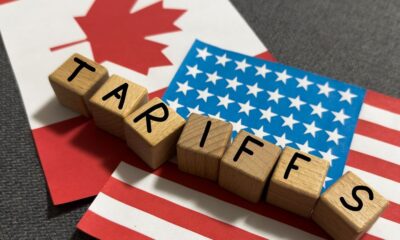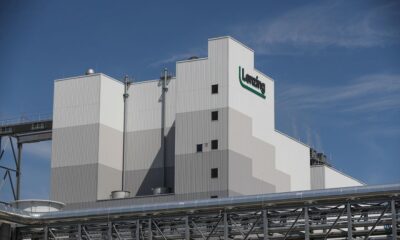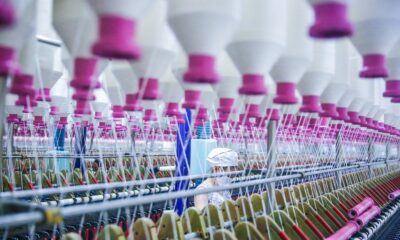Fashion
US reconciliation act to raise real potential output: CBO

Real GDP is the nation’s economic output adjusted to remove the effects of changes in prices.
In the near term, the net effects of the 2025 reconciliation act, higher tariffs and lower net immigration on aggregate demand and the labour supply drive most of the changes in the agency’s forecast. The reconciliation act reduced taxes for the vast majority of US households.
US growth in 2026 would be 0.4 pp higher than in the last projections by the non-partisan CBO, reflecting the 2025 reconciliation act’s boost to consumption, private investment and federal purchases and the reducing impact of uncertainty about US trade policy.
In 2027 and 2028, the effects of reduced net immigration and the waning of the reconciliation act’s near-term boost to demand would drag growth.
In 2025, the growth of real GDP is projected to be 0.5 percentage points lower in CBO’s current projections than it was in the agency’s January 2025 projections, primarily because the negative effects on output stemming from new tariffs and lower net immigration more than offset the positive effects of provisions of the reconciliation act this year.
In 2026, the reconciliation act’s effects boosting growth dominate the effects slowing it that stem from the reduction in net immigration. Waning of the elevated uncertainty about trade policy provides modest support to economic growth next year as supply chains begin to adjust to the higher tariffs.
Growth next year would be 0.4 percentage points higher than in the previous projections, reflecting the reconciliation act’s boost to consumption, private investment and federal purchases and the diminishing effects of uncertainty about US trade policy.
In 2027 and 2028, the effects of reduced net immigration on the labour force and the waning of the reconciliation act’s near-term boost to demand would act as a drag on growth.
Partially offsetting those effects, an increase in domestic production, driven by higher tariffs, provides a boost to economic growth. As a result, real GDP growth in those years is roughly the same as it was in CBO’s January 2025 projections.
In addition to boosting aggregate demand in the near term, the reconciliation act will, in CBO’s assessment, raise real potential output by increasing the supply of labour, the capital stock and the and total factor productivity (TFP), the average real output per combined unit of labour and capital, excluding the effects of cyclical changes in the economy.
Meanwhile, the CBO estimated that President Donald Trump’s tariffs would shrink the US economy and add to inflation while reducing the federal deficit by $2.8 trillion.
In a published letter to Senate Democrats, the CBO estimated the budgetary and economic effects of tariff increases that were implemented through executive actions between January 6 and May 13.
The analysis found that shrinking of the US economy would vary but said that tariffs would reduce GDP growth by 0.06 per cent each year, adding that real GDP will be 0.6 per cent lower in a decade than CBO’s earlier forecasts.
“In CBO’s assessment, the changes in tariffs will reduce the size of the US economy—in part because of tariffs imposed by other countries in response to the increases in US tariffs. After accounting for that change in the size of the economy, CBO estimates that the changes in tariffs will reduce total federal deficits by $2.8 trillion,” the letter said.
“Reductions in investment and productivity stemming from higher tariffs will be partially offset by increases in resources available for private investment resulting from the reduction in federal borrowing. CBO estimates that, on net, real (inflation-adjusted) economic output in the United States will fall as a result,” it added.
Fibre2Fashion News Desk (DS)
Fashion
Singapore edition of ITMA ASIA + CITME attracts global crowd

Combined with CITME, the four-day ITMA ASIA + CITME exhibition at the Singapore Expo concluded on 31 October 2025 with participants praising the international mix of visitors andstrong turn-out of buyers from the region. From the supply side, the exhibition was well represented by companies from key textile technology manufacturing regions, thus offering buyers a balanced selection of solutions.
ITMA ASIA + CITME 2025 in Singapore drew 26,600 visitors from 109 nations, with 92 per cent coming from overseas.
Over 840 exhibitors from 30 regions showcased innovations across 70,000 square metres.
Strong participation came from India, China, and Indonesia, reflecting Asia’s industry strength.
Next edition confirmed for Shanghai, November 20–24, 2026.
The Singapore exhibition attracted visitorship of over 26,600 from 109 countries and regions, reaffirming its reputation as the region’s most influential showcase of textile and garment manufacturing technologies.
Some 92% of the visitors came from overseas, with 35% of them from South Asia and 30% from Southeast Asia. The top three visitor countries were: India (19%), China (11%) and Indonesia (10%). Other countries in the top 10 list included Bangladesh, Pakistan, Vietnam and Malaysia.
The show owners – CEMATEX (the European Committee of Textile Machinery Manufacturers), China Textile Machinery Association (CTMA), The Sub-Council of Textile Industry, CCPIT (CCPIT TEX) – attributed its strong showing to Singapore’s ideal location, conducive business environment and seamless visitor experience.
Mr Alex Zucchi, President of CEMATEX, said: “Exhibitor feedback has been very positive as the high-quality visitorship and serious business discussions are greatly appreciated. The exhibition has created a strong sense of optimism about the opportunities ahead amid current economic challenges.”
Mr Gu Ping, President of CTMA remarked: “Asia, the world’s largest textile hub, boasts a vast industrial scale and plays a key role globally. With the successful conclusion of the ITMA ASIA + CITME, Singapore 2025, it is clear that the Asian textile industry, encompassing regions such as East Asia, Southeast Asia and the Middle East, is experiencing rapid development. This also reflects the global textile industry’s demand for exploring emerging markets.”
Many of the exhibitors were elated by the outcome of their participation. Mr Tobias Schaefer, Vice President of Andritz Nonwoven & Textile, enthused: “The combined exhibition in Singapore proved to be a truly pivotal platform, bringing together a remarkably international audience. The high visitor numbers, the quality of discussions, and the strong focus on innovation and sustainability reflected the industry’s evolving priorities.”
Mr Stephane Picard, Sales & Marketing Manager at Pierret Industries, opined: “We are very pleased with the overall quality of the visitors at the exhibition. Despite the current market challenges, the event exceeded our expectations. The main objective of holding this show in Singapore was to attract people from Southeast Asia and Middle East markets, and the results were truly impressive.”
Sharing the same sentiment, Canlar Mekatronik Board Member Mr Kaan Cakici said: “We’re delighted with the overwhelming response received at the exhibition. The show days were filled with serious enquiries from buyers who came ready to invest and we concluded business deals during the show. The quality of discussions with visitors at our stand has given us confidence to expand our presence and support in the region.”
Underscoring the significance of the 2025 exhibition for the Indian market was Mr Rohit Kansal, Additional Secretary, Ministry of Textiles of India who led a 30-member-strong government delegation.
Mr Kansal remarked, “India is one of the largest participants and exhibitors in this exhibition here in Singapore. This reflects our strategic vision in driving our textile industry’s growth through innovation, manufacturing excellence and sustainability. The fair provides a good meeting ground for people to exchange ideas, to look at new technologies, discuss business propositions and to see the latest innovations.”
Later, speaking at the co-located ITMA Sustainability Forum, Mr Kansal highlighted the Indian textile industry’s green transformation.
The comprehensive showcase of textile and garment making technologies at ITMA ASIA + CITME, Singapore 2025 occupied more than 70,000 square metres of gross space and featured over 840 exhibitors from 30 countries and regions.
ITMA ASIA + CITME, Singapore 2025 is organised by ITMA Services and co-organised by Beijing Textile Machinery International Exhibition Company.
The next ITMA ASIA + CITME exhibition will be held in Shanghai, China from 20 to 24 November 2026.
Note: The headline, insights, and image of this press release may have been refined by the Fibre2Fashion staff; the rest of the content remains unchanged.
Fibre2Fashion News Desk (MS)
Fashion
ICE cotton slips as weak US stocks, grains pressure market

ICE December cotton futures settled at 64.54 cents per pound, down 0.69 cents.
ICE cotton futures declined amid weakness in US stocks and grains, with traders awaiting the USDA’s supply and demand report due on November 14, 2025.
Technology and AI-related stock losses and uncertainty around President Trump’s tariff policies further dampened sentiment.
Brazil’s October cotton exports rose 5 per cent year-on-year, while ICE deliverable inventories remained steady at 13,749 bales.
Market analysts noted that the fall in the stock market was the primary driver behind the decline. Weakness in grain prices added further pressure on cotton values. US stocks closed lower on Thursday, extending losses from earlier in the week. Technology and AI-related stocks led the declines due to concerns about overvaluation and economic uncertainty.
The US Supreme Court heard arguments challenging President Trump’s broad tariff policies, heightening global trade concerns. US Trade Representative Greer stated that some plaintiffs could receive refunds if the court rules against the tariffs, subject to Treasury’s scheduling.
CBOT soybean futures fell sharply as optimism over renewed demand weakened following signs of easing trade tensions.
Traders are now focused on the USDA’s delayed monthly supply and demand report, scheduled for release on November 14, 2025. Despite the ongoing US government shutdown, the USDA confirmed it is collecting survey data for upcoming crop yield reports.
Brazil’s cotton exports totalled 293,928.51 tons in October, up 5 per cent year-on-year, with daily shipments averaging 13,360.39 tons, also up 5 per cent.
ICE data showed deliverable No. 2 cotton futures inventory unchanged at 13,749 bales as of November 05, 2025.
This morning (Indian Standard Time), ICE cotton for December 2025 traded at 64.66 cents per pound (up 0.12 cent), cash cotton at 62.04 cents (down 0.69 cent), the March 2026 contract at 65.90 cents (up 0.13 cent), the May 2026 contract at 67.11 cents (up 0.13 cent), the July 2026 contract at 68.07 cents (unchanged), and the October 2026 contract at 68.08 cents (down 0.51 cent). A few contracts remained at their previous closing levels, with no trading recorded so far today.
Fibre2Fashion News Desk (KUL)
Fashion
China retains lead as South Korea’s top textile supplier
-

 Business1 week ago
Business1 week agoPrinces Group valued at £1.16bn as food firm launches London float
-

 Tech1 week ago
Tech1 week agoNew diode chain could be used to develop high-power terahertz technologies
-

 Tech1 week ago
Tech1 week agoGiant, Spooky Animatronics Are 75 Percent Off at the Home Depot
-

 Fashion1 week ago
Fashion1 week agoUS Senate passes legislation challenging Trump’s tariffs on Canada
-

 Tech1 week ago
Tech1 week agoDisney content has gone dark on YouTube TV. Here’s what customers should know
-

 Business1 week ago
Business1 week agoChocolate’s reign over Halloween is under threat from inflation, tariffs and high cocoa prices
-

 Tech1 week ago
Tech1 week agoKeep Tabs on Your Pets and Kids With the Best Indoor Security Cameras
-

 Sports7 days ago
Sports7 days agoTudor’s Juve exit means McKennie must prove himself all over again



















